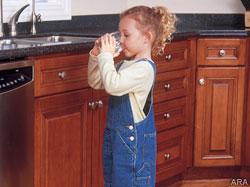
(ARA) – Home water filtration is no longer just about taste. People increasingly rely on it for healthy home benefits.
In fact, home water filtering devices should be used to decrease exposure to potential health hazards according to the President’s Cancer Panel (PCP). This panel reports to the president of the United States and is charged with developing and executing strategies to reduce the “unacceptable burden of cancer” on Americans.
Specifically, the report states: “Individuals and families have many opportunities to reduce or eliminate chemical exposures. For example, filtering home tap or well water can decrease exposure to numerous known or suspected carcinogens and endocrine-disrupting chemicals.” Further, the panel asserts, “unless the home water source is known to be contaminated, it is preferable to use filtered tap water instead of commercially bottled water.”
While the PCP acknowledges that further study is needed to determine the full range of cancer risk associated with environmental exposure, Water Quality Association Executive Director Peter J. Censky says that home water treatment is a proven final barrier against many harmful chemicals.
“Filtration is a simple step toward better health for you and your family that can provide proven results. Many filters undergo rigorous third-party testing to prove their abilities to effectively remove contaminants,” says Keith Brown, senior technology advisor with leading filtration manufacturer Kinetico.
Some common filtration options, however, do not provide adequate defense against contaminants that may lead to cancer. While many water carafes and faucet mounts are effective at removing common water impurities, often these types of filters only employ a carbon filter that is not proven to trap many of the complex organic compounds like the endocrine disrupters mentioned in the PCP’s report.
“Some of these compounds require more sophisticated filtration options because of their unique chemical properties,” Brown says. These systems filter water at the point of use for drinking and cooking. They are generally placed under the kitchen sink but can be installed in basements, garages or wherever else is convenient.
“Homeowners concerned about what could be in their water should first research their water source and have it tested. If those investigations or the test results determine a need for water treatment, they should consider using a reverse osmosis drinking water system,” says Brown. “It forces water through a membrane with pores about 50,000 times smaller than a human hair. The contaminants get rejected by the filter and you’re left with water that is nearly free from all impurities.”
In fact, the Environmental Protection Agency, recommends reverse osmosis (RO) systems to most effectively remove a larger number of contaminants that may be in water. RO systems have also been proven by the American Water Works Association and many university studies to effectively remove endocrine disruptors.
“The filtration system best suited to any particular home is determined by assessing the quality of the home’s tap water and the level of concern it presents,” Brown says. “Water filtration system dealers will have the resources to help ascertain what concerns are present.”
With a thorough water quality evaluation and the proper filtration system, a tall glass of water can be virtually contaminant free. “And homeowners can rest easy knowing they have taken an important step in creating a healthier environment in their home,” says Brown.
To learn more or to arrange a free in-home water quality analysis, visit www.kinetico.com or call (800) 944-9283.





